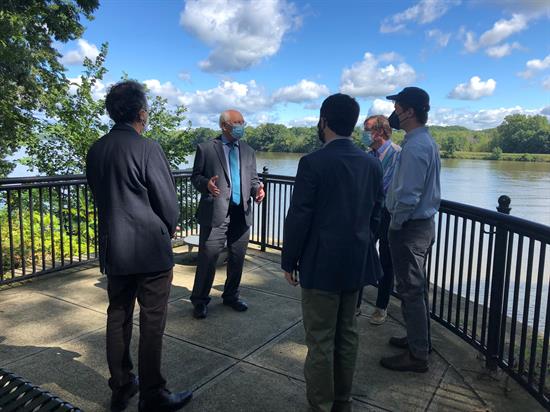- Home
- About
-
Constituent Services
- Academy Nominations
- Community Project Funding
- Congressional Art Competition
- Congressional App Challenge
- Congressional Commendation
- Event Invitation
- Grants
- Help with a Federal Agency
- Internships
- IRA Clean Energy Consumer Benefits
- Know Your Rights: Immigration
- Request a Meeting
- Request Surplus Books
- Presidential Greeting
- Visit Washington D.C.
- Issues & Legislation
- News
- 20th District
- Contact

Press Releases
Tonko Leads Hearing on Repairing America’s Water InfrastructureHighlights major investments to deliver clean water to communities through Bipartisan Infrastructure Law
Washington,
March 29, 2022
WASHINGTON, DC—Congressman Paul D. Tonko, Chair of the Environment and Climate Change Subcommittee, led a hearing today highlighting key investments in the Bipartisan Infrastructure Law to repair the country’s crumbling water infrastructure and deliver clean water to communities. Tonko has worked in Congress for years to ensure Americans have access to safe drinking water, and successfully fought to bring billions in funding to the Drinking Water State Revolving Fund through the Bipartisan Infrastructure Law. View Rep. Tonko’s opening remarks HERE and see as prepared for delivery: For many years— under both Democratic and Republican majorities— this committee has heard from a chorus of state and local governments, public health and environmental organizations, labor unions, and American manufacturers, urging Congress to provide greater Federal assistance in support of our nation’s crumbling water infrastructure. We are all too aware of water systems’ struggles: frequent main breaks, massive leaks of treated water, PFAS contaminations, and an estimated 10 million lead pipes in service— which are overwhelmingly found in low-income communities and communities of color. These challenges, on top of a growing backlog of maintenance projects, put financial stress on local governments and water authorities, which translates to rate increases for water users. I believe that every federally elected official should bear some responsibility and, frankly, some shame that there are so many Americans that lack access to safe, reliable, and affordable drinking water. Only since last year can we say that we have made an honest attempt to tackle the scale of this problem. Last year’s Bipartisan Infrastructure Law made an historic down payment to address our long-neglected water infrastructure. It included more than $50 billion for water systems, and today we will have an opportunity to examine the funding being distributed through the Drinking Water State Revolving Fund. This includes $11.7 billion to supplement the Drinking Water SRF’s annual appropriations, $15 billion for the replacement of lead service lines, and $4 billion to address emerging contaminants in drinking water, such as PFAS. Furthermore, Congress has required that 49% of the funds for the SRF supplemental and lead lines be provided as grants and forgivable loans to disadvantaged communities. Given this historic investment, there will certainly need to be some adjustments made by states. And with that in mind, earlier this month, EPA issued an implementation memo to provide information to states on how to best administer these new funds. And by providing this funding through the SRF, states have flexibility to meet their unique needs. This is the nature of the cooperative federalism enshrined in the Safe Drinking Water Act, and I have no doubt that it can continue to be a successful model. It is my expectation that EPA will continue to provide technical assistance and guidance on how states can make the most of these funds, including by identifying best practices to enhance capacity building and program access for rural and disadvantaged communities. We know that ramping up state and local governments’ capacity to administer these funds effectively will have its challenges. But we should not allow these challenges— which can and will be overcome by committed states— to overshadow the immense opportunity being provided by this funding. States and local governments will finally be able to address their immense infrastructure backlogs. They will have a pipeline of resources to enable recruitment and training of the next generation of water sector employees. And the ability to access SRF funds as grants and forgivable loans provides new opportunities to small and disadvantaged systems that previously would never have been able to consider a SRF loan. It is no surprise that stakeholders, such as the National Rural Water Association and the Rural Community Assistance Partnership, have submitted letters, which will be entered into the hearing record later today, that celebrate this funding’s potential benefits to rural communities. The Bipartisan Infrastructure Law will result in long overdue work getting done. It will fund projects that will make Americans healthier. And it will create jobs. The City of Newark has proven it can be done. And the work being done in Milwaukee is further confirming that there are replicable models for removing lead lines and repairing infrastructure that results in developing a localized, unionized workforce. This funding will not solve all our nation’s water issues. There is still work to do, both to ensure effective implementation of these funds as well as efforts to improve water affordability, system resilience, and standard setting. But I am excited that today we will hear from state, local, public health, and labor organizations to understand the opportunities created by the Bipartisan Infrastructure Law. I want to thank our witnesses for joining us this morning. I look forward to your testimonies. ### |
